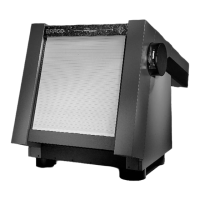Field Service Manual December 2003
Page 177 of 276
Introduction
Optics principle
Resolutions
Optics 300/600(SW8XX) has a basic resolution of 4000 ppi and offers the following most
common used resolutions (fixed spot size around 7 um ):
From 4000 ppi upto 25400 ppi.
Most used :
Imperial 4,000 5,000 8,000 10,000 16,000 20,000 25,000
Metric 4,064 5,080 8,128 10,160 16,256 20,320 25,400
Syntectic plotting
SYNTECTIC PLOTTING is based on "interlaced scanning".
The word syntectic is derived from the Greek.
In practice, when you are exposing on film, you expose with one or more
beams in the fast scan direction per revolution. The actual quad beam
optic uses 4 contiguous beams per revolution: beams 1, 2, 3 and 4 are
respectively drawing the first, second, third and fourth lines during the first
revolution of the drum; the fifth, sixth, seventh and eighth line during the
second revolution and so on. This is a non-interlaced exposure.
One of the most important drawbacks of this kind of exposure is the fact
that some beam overlaps occur simultaneously and others occur
subsequently (beam 4 of rev n and beam 1 of rev n+1). For some new
films (Agfastar, Kodak Ultratech), the delay between the two exposures
makes the emulsion behave as if it were more sensitive. This can produce
a local line width increase and hence reduce the quality of the exposed
image.
In TV techniques, interlaced scanning is used: all the odd horizontal
lines are scanned first, then the even lines. In a certain way, this is what
the new optics does, but instead of exposing one line at a time, it is writing
with 12(24) beams at a time. So after one revolution, it has plotted 12(24)
lines with a distance between the lines of twice or thrice the resolution. So
after one revolution, a second and third revolution are needed to fill the
gaps between the lines drawn in the previous revolution.

